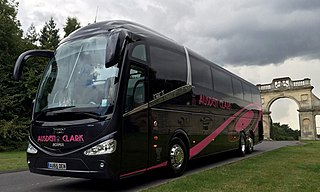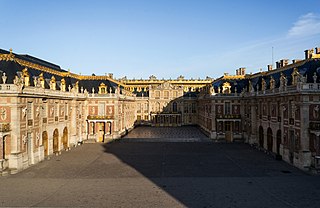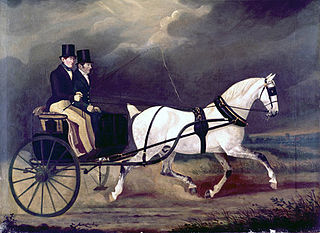
A coach is a type of bus built for longer-distance service, in contrast to transit buses that are typically used within a single metropolitan region. Often used for touring, intercity, and international bus service, coaches are also used for private charter for various purposes. Coaches are also related and fall under a specific category/type of RVs.

A stagecoach is a four-wheeled public transport coach used to carry paying passengers and light packages on journeys long enough to need a change of horses. It is strongly sprung and generally drawn by four horses although some versions are drawn by six horses.

A carriage is a private four-wheeled vehicle for people and is most commonly horse-drawn. Second-hand private carriages were common public transport, the equivalent of modern cars used as taxis. Carriage suspensions are by leather strapping and, on those made in recent centuries, steel springs. Two-wheeled carriages are informal and usually owner-driven.

A mews is a row or courtyard of stables and carriage houses with living quarters above them, built behind large city houses before motor vehicles replaced horses in the early twentieth century. Mews are usually located in desirable residential areas, having been built to cater for the horses, coachmen and stable-servants of prosperous residents.

A porte-cochère is a doorway to a building or courtyard, "often very grand," through which vehicles can enter from the street or a covered porch-like structure at a main or secondary entrance to a building through which originally a horse and carriage and today a motor vehicle can pass to provide arriving and departing occupants protection from the elements.

A brougham was a light, four-wheeled horse-drawn carriage built in the 19th century. It was named after the politician and jurist Lord Brougham, who had this type of carriage built to his specification by London coachbuilder Robinson & Cook in 1838 or 1839. It had an enclosed body with two doors, like the rear section of a coach; it sat two, sometimes with an extra pair of fold-away seats in the front corners, and with a box seat in front for the driver and a footman or passenger. Unlike a coach, the carriage had a glazed front window, so that the occupants could see forward. The forewheels were capable of turning sharply. A variant, called a brougham-landaulet, had a top collapsible from the rear doors backward.

A coachbuilder or body-maker is someone who manufactures bodies for passenger-carrying vehicles. Coachwork is the body of an automobile, bus, horse-drawn carriage, or railway carriage. The word "coach" was derived from the Hungarian town of Kocs. A vehicle body constructed by a coachbuilder may be called a "coachbuilt body" or "custom body".

A cour d'honneur is the principal and formal approach and forecourt of a large building. It is usually defined by two secondary wings projecting forward from the main central block, sometimes with a fourth side, consisting of a low wing or a railing. The Palace of Versailles (illustration) and Blenheim Palace (plan) both feature such entrance courts.

Harwich International railway station on the Mayflower Line, a branch of the Great Eastern Main Line, serves Harwich International Port in Essex, England. It is 68 miles 72 chains (110.88 km) from London Liverpool Street, between Wrabness to the west and Dovercourt to the east. Its three-letter station code, HPQ, derives from its original name, Harwich Parkeston Quay.
The Whitlock company, based in London, England, started as a carriage builder in 1778, moved into the car industry in 1903 and finally closed in 1991.

Thrupp & Maberly was a British coachbuilding business based in the West End of London, England. Coach-makers to Queen Victoria they operated for more than two centuries until 1967 when they closed while in the ownership of Rootes Group.

Hooper & Co. was a British coachbuilding business for many years based in Westminster London. From 1805 to 1959 it was a notably successful maker, to special order, of luxury carriages, both horse-drawn and motor-powered.

A coach is a large, closed, four-wheeled, passenger-carrying vehicle or carriage usually drawn by two or more horses controlled by a coachman, a postilion, or both. A coach has doors in its sides and a front and a back seat inside. The driver has a raised seat in front of the carriage to allow better vision. It is often called a box, box seat, or coach box. There are many of types of coaches depending on the vehicle's purpose.

The stanhope was a gig, buggy, or light phaeton, typically having a high seat for one person and closed back. It was named after Captain Hon. Henry FitzRoy Stanhope, a well-known sportsman of his time, and built by the London firm of Tilbury, coachbuilders in Mount Street.
Mulliners Limited of Birmingham was a British coachbuilding business in Bordesley Green, with factories in Bordesley Green and Cherrywood Roads. It made standard bodies for specialist car manufacturers. In the 19th century there were family ties with founders Mulliners of Northampton and the businesses of other Mulliner brothers and cousins but it became a quite separate business belonging to Herbert Mulliner.

The Remington Carriage Museum is located in Cardston, Alberta, Canada. Opened in 1993, and the largest of its kind in the world, the Remington Carriage Museum displays more than 240 carriages.

Barker & Co. was a British coachbuilder, a maker of carriages and in the 20th century bodywork for prestige cars, including Rolls-Royce, Bentley, and Daimler.

O'Gorman Coachbuilders was an Irish coach building company that traded under various names from the 1920s to the 1940s.
Several monarchs have used golden coaches. These horse-drawn coaches were made of wood and covered with gold leaf, a solid golden coach would be very expensive and so heavy that it would be a practical impossibility.

William Vincent Ltd., often known as Vincent of Reading, was a British coachbuilder founded in 1805 making carriages but in 1899 they made their first car body and later made bodies for commercial vehicles.


















